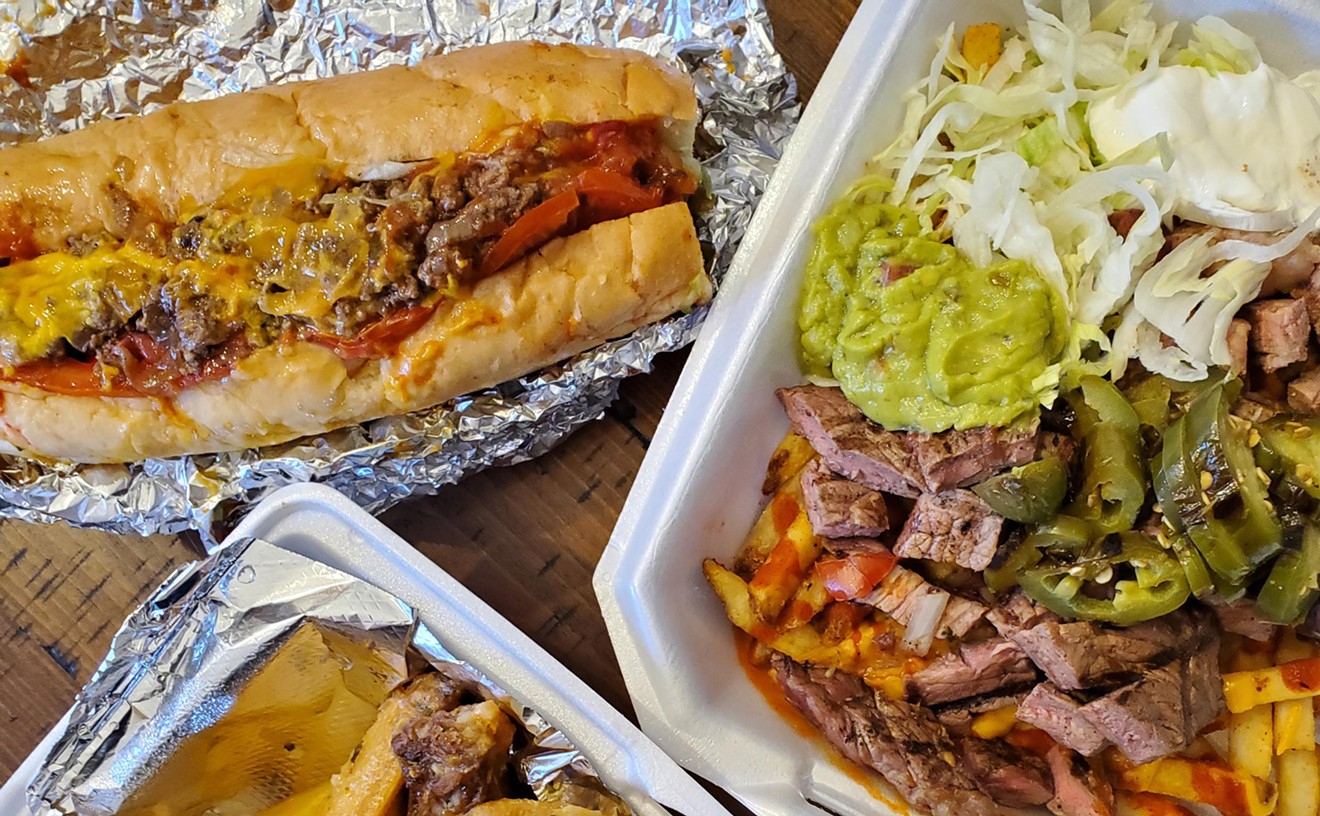The soup.
The free bread on the table gets more care and attention. The salads -- soup's counterpart in the gratis soup-or-salad course -- are practically lavished with love by comparison. I've known restaurants that kept one pot of soup going for days, letting it boil down and steam away, then refreshing it with tap water and salt over and over and over again. I've eaten (and made more times than I want to admit) B-soup and C-soup out of last night's dinner-service leavings and produce gotten at massive discounts from purveyors who know their squash or tomatoes or mustard greens are too far gone for center-plate use. That's good for the kitchen's bottom line, sure; you'd be surprised at the kind of money you can get for a warm bowl of comforting, orange winter-squash soup laced with whorls of crème-not-so-fraîche when no one in the dining room can see your pantry cook carving the rotten spots out of three cases of butternut.
So abused is the poor soup course, so lacking in love and dignity, that every time I'm presented with that Sophie's Choice of soup or a pre-made, half-frozen salad of iceberg, shredded cabbage, lopsided cucumber slice and desiccated wedge of wasted tomato, I go with the soup -- not because it's the safer or more appetizing choice, but because I like to try and taste my way through the history of the ingredients bumping together in the bowl. How long, I wonder, did this celery languish in the murky bottom of some garde-manger man's lowboy before it was discovered, hacked up and thrown in the pot? How badly did the weekend's monkfish special have to sell before the cruel mathematics of food cost turned it into the star of a turgid Fisherman's Stew on Sunday afternoon?
The kitchen business, while absolutely rife with art and genius on the one end, is, at the other, a no-nonsense shirttail operation where numbers talk and most chefs end up playing the shivering Bob Cratchit to their owner's Ebenezer Scrooge, who denies them another piece of coal for the stove because the week's P&L won't allow it. Soups, brunches, vegetarian menu options and Tuesday-night clear-the-coolers pasta specials go a long way toward alleviating the pressure built up by bills coming due on Wednesday.
So, given soup's usual slapdash treatment, imagine my surprise when, after presenting me with the soup-or-salad question, my Cafe Jordano server brought a small cup of nameless white-bean-and-spinach soup that was so good -- so warm and light and well-balanced between the saltiness of the chicken broth, the green murk of shredded, poached spinach and the perfectly cooked white beans -- I actually went into a pout when it was gone, scraping my spoon dejectedly along the bottom of the cup, wanting just one more spoonful, then another, then another.
Okay, I wasn't that surprised. I'd been making wildly irregular visits to this strip-mall trattoria since I first arrived in Denver and heard about a little place in Lakewood that didn't take reservations because if it did, there'd never be an open table for the neighbors; where regulars would arrive a half-hour before the start of dinner and wait in their cars or out on the sidewalk, jockeying for position and counting heads to make sure they'd get a seat at that all-important first turn of the dining room. I'd learned the drill at Cafe Jordano and already knew that very nearly everything the restaurant does -- from the smallest touch of service to the most labor-intensive entree -- is wonderful and well-considered. And yet the cooks can still shock me at every meal with just how good their Italian food can be, when mediocrity has become the best I expect.
The thirteen-year-old Cafe Jordano is one branch of an extended family tree whose New York roots are also responsible for bringing us Armando's (with its great Sicilian spinach pies and pastas) and Vita Bella (an avatar of East Coast mom-and-pop eye-tie in Superior). The relationship goes something like this: Elisa Heitman, who owns Jordano with her husband, Troy, is the aunt of Anthony Sarlo, who owns Vita Bella. Anthony's father owns Armando's (three of them, actually, including the original in Cherry Creek, where Anthony earned his chops), and Anthony's grandfather (on his mom's side) was a legend of the New York scene, owning seven restaurants, including the Oriental Manor, where, once upon a time, Henry Hill's wedding scene in GoodFellas was filmed.
GoodFellas -- that's some heavy street cred for any Italian joint.
Cafe Jordano, in turn, can trace its heritage right through GoodFellas and back to the old neighborhoods of the Big Apple, back to the mother country, as it were, of American street-corner Italian cuisine and the checkered tablecloths of classic trattoria dining. I've come to learn that this lineage is vital, that without it, Midwestern kitchens have a tendency to suffer from tastebud blindness -- the inability to cook authentic, urban-traditional Italian food because no one on the line has ever tasted the real thing.
I learned to cook by eating, by perpetually falling in love with the dishes and preparations of other cooks. I was never a particularly creative chef, but I was a superlative mimic. Italian, the first cuisine I tackled, came easy because I'd grown up eating it and had a range of reds, whites, scaloppini and ravioli to draw from when the chef slapped me down in front of the ten-top range and said "Make sauce," with no further instruction than that. It was a cinch. I knew Italian like a second language.
But French was different. Escargot? Côte de boeuf? What the fuck? I'd never tasted anything more French than fries and toast, so I had to build myself a flavor lexicon, fast, which I did by eating myself stupid -- tasting this and sampling that and learning from the inside out how a dish was supposed to be once all the cooking, seasoning and plating was done. Luckily, I'm a quick study: In my first few weeks, I'm pretty sure I set back the clock of fine cuisine by 200 years.
Tastebud blindness -- that's what I was suffering from when I first made the jump from Italian to haute Frog. The chef could give me a recipe, a picture, a textbook, whatever, and I could make a côte de boeuf, but it wouldn't be a good côte de boeuf, because I had no idea what a good one was supposed to taste like. People cooking Italian in any city west of the Mississippi, where there isn't an ingrained tradition of eating good Italian, have the same problem: How can cooks make a proper alfredo, arrabbiata or Marsala if the closest they've come to one is a glossy centerfold in Food Arts? They can't. Hence the profusion of very bad Italian for a thousand miles in every direction from my house.
But Cafe Jordano knows good strip-mall Italian. And that's what the kitchen cooks, every day but Sunday, for crowds who've come to understand that the Olive Garden is not the be-all and end-all of Italian food, no matter how many free breadsticks the grinning waitron hands you.
Sitting on the high-backed wrought-iron chair, closed in by the mustard walls, surrounded by couples and families, attended to by the friendly, happy, accommodating floor staff -- the small army of servers needed to get us all watered, fed and sent on our way -- I finally surrendered my empty soup cup. Then I chased my blues away with gamberi e cozza alla Franco, big, sweet shrimp and a raft of black mussels in a brandied tomato cream sauce. The sauce was thick, monstrously heavy, brightened by the bitter spike of capers, grounded with a smokiness that tasted of flamed liquor and coddled tomatoes. Alla Franco? Not hardly. My schoolboy days are long gone, so I know from alla Franco now, and this was purely alla Romana.
I chased the seafood with homemade potato gnocchi in red sauce, each of the seashell-looking thumbs of pasta rolled by hand, crimped under a fork, bathed for thirty seconds in scalding hot water, then buried under a basic red gravy and a thick cap of baked mozzarella. Still hungry, I had the cannelloni con pollo e asparagi: more homemade pasta, hand-formed and stuffed with chicken sausage, laid with (admittedly limp) stalks of asparagus and smothered in a tomato cream sauce that came from the same mother as the sauce attending the mussels, but brought up differently. No brandy, no capers, and a fresher, more solid tomato taste.
Still not satiated, I ordered cannoli. These were great cannoli, beautifully simple in stiff shells, with a sugary mascarpone cream that hadn't gone flat or gritty or chalky through repeated breaking or seizing and reconstitution at the hands of an inexpert pastry chef.
I couldn't wait to eat my meal all over again.
So on Saturday night, we joined the crowds staking out the joint early and made the first seating. I gorged myself on Italian crostini topped with prosciutto and mozzarella, then a plate of ravioli that, despite its reputation as a staple, a standby, had received just as much care, with a sauce that was a solid red -- not watery, not oily, neither too sweet nor too spicy. As fine as that sauce was, though, I couldn't resist swirling bits of the ricotta-stuffed ravioli in the thick and cheesy alfredo slopping up over the edges of my wife's plate of chicken and spinach fettuccine firenze.
Cafe Jordano's menu is a riot of flavors and colors. There's not a ringer in the bunch of elegantly composed, plainly presented dishes. I keep going back thinking that this time, for whatever reason, the food won't be how I remember it. That the artichoke hearts in the saporito can't be as sweet as I recall, just barely kissed by wine in a hot pan. Or the pollo alla Roberts ("Bob's favorite"), with its tender, poached and pounded chicken buried under a cardiopulmonary horror show of butter and wine and heavy cream and three different kinds of cheese, can't possibly be as good as I remember it -- because I remember it as one of the most luxuriously decadent plates I've had in a lifetime of chasing luxury and decadence on the plate. Only it is that good every time, with the kitchen pulling off a composed sauce so tough and heavy that it's unbreakable, yet buoyant enough that eating a whole bowl of it won't make you feel like you've swallowed a bowling ball.
The tastes here are old ones, classics that have survived every fad and Next Big Thing to come roaring through the restaurant scene over the past hundred years. They're tastes with history, flavors that come out of generations of love for food and of understanding how people want to eat when they're just having dinner and not going out to dine.
Cafe Jordano is the kind of place you're sad to leave, because coming here always feels like visiting family, and leaving feels like having to say goodbye. It's the kind of place you want to go back to fifteen minutes after you've left -- gladly braving the crowds again -- just to try something new that you might have missed on your first, fifth or fiftieth time through the menu. But even if you haven't missed anything, that same perfect cup of soup, that burst of Italian from the kitchen, that smell of browning garlic in the air, will always make eating here a pure pleasure.










